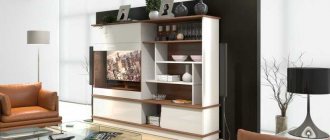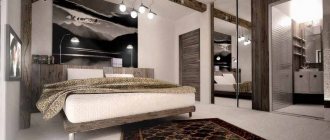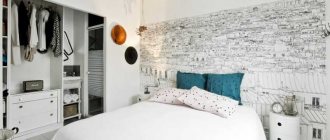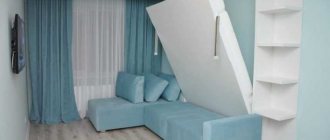Previously, if there was a need to combine a bedroom and a living room, the room was furnished with a sofa. They slept on it and received guests. This, of course, is not very convenient: the need to constantly fold and unfold the sofa and make the bed will tire anyone. But people put up with imperfection. After all, it was necessary to save space - for example, for a bulky wall.
Over time, a lot has changed. Now, if not all, then most understand that comfortable and healthy sleep is more important than an additional wardrobe. A bed is not a luxury, but an absolute necessity. However, you shouldn’t give up the sofa either. After all, receiving guests on the bed is, frankly speaking, not comme il faut. And sometimes we ourselves want to sit comfortably, leaning back. In general, a tiny sofa is better than no sofa.
If space allows, the children's room should also be equipped with both a bed and a sofa. A child needs a high-quality orthopedic mattress even more than an adult. A sofa wouldn’t hurt either: it’s very comfortable for receiving guests and watching TV, as well as for communicating, reading, playing games, etc.
So, it’s decided - we furnish an adult or children’s room with both a bed and a sofa. How to install them? What to place between them? Let's look at a few typical solutions.
The head of the bed and the back of the sofa are on one wall
This is the most common plan. The sleeping area of the bed and the sitting area of the sofa are parallel to each other.
Design: DA Interiors
Pros. If there is a TV on the opposite side, you can view it from both points. Usually, with this position of the bed, it is possible to leave passages to both sleeping places, which is important from the point of view of ergonomics.
Minus. For a narrow room, this arrangement is not very suitable - a bed standing across it will block the passage.
Design: Allarts-Design
Design: Vera Vasilenko
Design: DA Interiors
Design: Korneev Design Workshop
In what cases is such a neighborhood appropriate?
It is appropriate to combine a bed and a sofa in the same room in the following situations:
- you live in a one-room apartment or studio apartment and cannot afford a division;
- you live with children in a two-room apartment, so the second room was equipped as a nursery;
- for a comfortable sleep you need to have a bed with an orthopedic mattress (but living conditions do not allow you to have a separate room for a bedroom).
In fact, there can be a lot of reasons for such a neighborhood; only the most common of them are given here.
Long side of bed and sofa - along one wall
The sleeping area of the bed and the seating area of the sofa are located perpendicular to each other. This is the second most popular layout.
Plus. The bed stands along the room, so it doesn’t clutter it up so much.
Minus. If the length of the bed is adjacent to the wall, there is no passage to one of the sleeping places, which significantly worsens the ergonomics of the interior.
Design: Roman Safonov
Often this layout option is chosen for rooms with a recess. If the bed fits into a niche, great. That's where she belongs.
Living room-bedroom design: 6 types of space division
- Just a bed and a sofa in one room
- Construction of a partition
- Sliding doors on rollers
- All kinds of curtains and drapes
- Shelving and various translucent structures
- Screens
- The bed is located under the ceiling
Now let’s look at each method in more detail with illustrations and find their pros and cons.
Bed and sofa in the room
Not separated by anything. This is my favorite method because it allows you to better preserve the space of the room, air, light, volume. It can be used for any room proportions and any window arrangement. The main thing is to move away from the literal understanding of the concept of “space zoning”.
I strongly suspect that this term was brought to the masses by one TV show about repairs, where the editors understood it literally. In fact, it is not at all necessary to physically divide the room with something in order to get these notorious functional zones. The furniture itself, placed in groups in different places, already designates them. Sometimes it is enough to place a chair not against the wall, but in the middle of the room and it will separate the sofa and coffee group. You can also use a coffee table, pouf, etc. And two carpets, two light sources, etc. can additionally emphasize the zones.
Perhaps it’s generally worth choosing two chairs.
The same chair in the center of the room that I was talking about. It closes off the living space. Opponents of this method have an ironclad argument: the bed is an intimate place and it should be covered from view. Of course there is some reason for this. But personally, I think that a cleaned, made bed is no more intimate than a folded sofa bed. The forms are different, but the content is the same.
Construction of a partition
An option for those who still want to keep the bedroom area private, or get a corner for privacy. Typically, partitions are built from plasterboard or other lightweight material. It is more convenient to use if the room is elongated and has several windows on a long wall. If the window is at the end, then most likely this option will not work. Otherwise, half the room will not receive sunlight. But there is still one way, I’ll show you below.
Here the designer acts very unconventionally and uses glass partitions. Personally, I don’t really understand the functional load of such a wall, but I won’t argue with the fact that it’s beautiful :))) Light enters the bedroom, the separation, of course, is very conditional. And it costs a lot...
This is the very method that I promised to show. There is no more accurate illustration, but I think you can get the meaning. In the photo, due to the fact that there is no window in the bed area, the designer uses a non-standard move - he erects a low partition. As a result, both parts receive light, the space is not divided into tiny cells, and minimal privacy is ensured.
If you still don’t understand, then I’ll explain. In the same way, you can place a bed at the end window, and a sofa closer to the exit, separated by a low partition about one meter high.
Sliding doors on rollers
Essentially these are the same walls, but if necessary, the bed is completely hidden from view. I don't like this option due to the price. It might be easier and cheaper to choose something else.
All kinds of curtains and drapes
To divide the space of the room, mobile devices made of fabric are used, which can be easily opened and closed at the right time. Basically, this is just an economical version of sliding doors. A good solution when there is a need to temporarily hide the bed from prying eyes. It is very convenient when it is possible to place the bed in a recess like a niche. Advantages: low cost and mobility.
Shelving and various translucent structures
Here we say a huge thank you to IKEA. The Kallax rack (an old similar model was called Expedit) is an almost irreplaceable thing, with the help of which a room is very often zoned. Similar racks are available from other manufacturers. Other models will also fit. This option is convenient for elongated rooms when the window is located only on the end wall.
Thanks to its lightweight design, the shelving unit does not completely block the light and ensures privacy in the sleeping area. Plus this is additional storage space.
Zoning with a screen
Not the most common option. But if you have a beautiful screen, the solution is very aesthetic. It is also often used in elongated rooms with a window on a short wall. A screen is better than a shelving unit in that it is more compact and sleeker in size, brings uniqueness to the interior, and can always be removed if you get tired of it. The disadvantage is that the furniture is very exotic, there is a very small assortment, beautiful screens are completely inexpensive, although you can make a simple screen yourself.
If associations with a medical office don’t bother you, then this is quite an option.
The “wall” sofa is parallel to the “island” bed
Here, as in the previous plan, the sleeping and sitting places are perpendicular to each other.
Plus . There are free approaches to both sleeping places.
Minuses . The sofa overlooks the bed, which deprives the sleeping area of privacy. The arrangement is only suitable for very spacious rooms.
Design: Harmony Interiors
Bedroom-living room in classic style
A bedroom-living room, decorated according to all the rules of the classic style, will look more like a full-fledged bedroom with a small sitting area. The bed will occupy a central place - it will be decorated with a canopy, rich textiles and pillows. If there is a need to balance two zones in importance and equip a comfortable living room area, then it is better to use a modern classic style. The design of a modern bedroom - living room allows you to maintain an atmosphere of grandeur, but looks lighter, more spacious and not overloaded with details.
Zoning a room into a bedroom and living room Source karaokerox.ru
Here are some recommendations for decorating a bedroom with a living room in a modern classic style:
- Furniture is arranged in compliance with symmetry, as in the traditional version. The pastel color scheme remains, but a wider selection of decorative elements and finishing materials appears.
- A distinctive feature of the style is the presence of an accent wall at the head of the bed. This decorative technique allows you to visually highlight one of the zones. To do this, use textured wallpaper with an ornament or a bright pattern.
- The bed and the living room area are separated by thick curtains, while the sleeping place is located near the window.
- Textiles, carpet and pillows on the sofa in the living room area are used as bright accents - this will allow you to divert attention from the sleeping area. In this case, the fabric should have a simple texture - embroidery and satin shine will be inappropriate.
- The picture above the sofa can be replaced with a black and white wide-format photograph, and instead of a massive chandelier, modern lamps stylized as classics can be used.
- So that the sleeping place does not attract attention, the bed is chosen to be of a simple shape, without gilded or carved details.
- Since it is impossible to imagine a living room without modern equipment, hidden storage techniques are used - this will preserve the classic atmosphere in the interior. The TV can be placed in an improvised picture frame, but it should not look pretentious.
Interior with photographs Source novolitika.ru
A bedroom - living room in a classic style involves the use of natural materials, but in a modern interpretation of the classics it is possible to use high-quality analogues.
Sofa in front of the bed
Usually the sofa is turned away from the bed, but sometimes it is turned “facing” it.
Design: studio Juicy-hall
Design: TrioDesign
Plus. The island and peninsular arrangement of the sofa and bed allows you to free up space near the walls. It can be placed under cabinets or a desk.
Minus. Suitable only for very spacious rooms.
Loft style
In a living room combined with a bedroom, the loft style will be as appropriate as minimalism. Both of these styles promote maximum natural light, which makes even the smallest room feel spacious.
Design of a combined room Source www.interiordesign.net
The loft style was originally intended to combine several functional areas, so it will look organic and natural when combining a living room and a bedroom. Features of the loft style include the following:
- The special atmosphere of the loft style is built on the contrast of the juxtaposition of seemingly incompatible things. Elegant interior decor looks especially impressive against the backdrop of brickwork, concrete or rough wood.
- Lots of natural and artificial light. This style welcomes high window openings, often of non-standard shape, the presence of a light well or its imitation. For lighting in the evening, not only hanging garlands of incandescent lamps, but also industrial spotlights can be used. It is important to create uniform lighting throughout the room.
- It is important to strive to make the room as spacious as possible. To do this, it is recommended to use multifunctional furniture, hidden facades for dressing rooms, niches. You can also replace a wide window sill with a narrow one, and hang blinds on the windows.
- The furniture deserves attention. It can be either ultra-modern or homemade. However, it should not be a single set. The interweaving of eras is welcomed - a modern sofa and an antique armchair, wooden stools and plastic chairs. The bed can be made of solid wood with forged decor. All furniture must be mobile; for this purpose it is equipped with wheels.
- To make the loft cozy, there is a place for a fireplace.
Studio apartment Source triodesign.org
This style is quite diverse. Brickwork, ceiling wooden or steel beams, communications under the ceiling and along the walls, valves, switches, technical plates and signs are used as decorative elements.
Sofa and bed on two opposite walls
You rarely see such a furniture arrangement. However, in Scandinavia it is very common.
Pieces of furniture can stand directly opposite each other or be placed diagonally.
Pros. There is usually quite a lot of space left between the sofa and the bed. The aisles are spacious and comfortable. The living room and bedroom areas can be placed on one half of the room, devoting the second to a dining room, office, etc.
Minus. If pieces of furniture are directly opposite each other, both places (sitting and sleeping) are deprived of even a small amount of privacy.
Options for placing a bed and sofa in a one-room apartment
There are no limits to the imagination of designers. Sometimes they manage to fit a bed and a sofa into one living room so organically that at first glance it is not even possible to immediately realize that the room is both a living room and a bedroom. Here are some options for placing these pieces of furniture that will help you solve the problem of lack of space.
Don't share anything
By the way, designers really love this method. It allows you to save the entire space of the room in full. Suitable for arranging a room of any size, proportions and with any arrangement of windows. You just need to force yourself to move away from the literal perception of the term “space zoning.”
It is not necessary to delimit the space by any physical means. Even the usual grouping of furniture when arranging will help to visually divide the room into zones.
For example, place a sofa against the wall, a coffee or coffee table in front of it, and surround it with chairs or armchairs. Move the bed to the far corner of the room, lay a rug next to it, place two bedside tables on each side and surround it all with nightlights. And now you already get a visual division of space into zones without any screens or walls.
Photo: Zoning in the bedroom - living room
Partition
This option is more suitable for those who still want to make the sleeping area more private. Typically, partitions are built from plasterboard or any other lightweight material, including one that transmits light. The method works well in elongated rooms in which several windows are located on a long wall.
The length of the partition can be adjusted. For example, make it low. This will help to divide the room, and still leave the total volume of space unchanged. However, such a partition is unlikely to add privacy to the sleeping area. With this arrangement, the sofa can be placed closer to the exit, separating it with a partition, the height of which does not exceed a meter.
Doors on rollers
Sliding doors are essentially the same walls, only hiding the bed from view when necessary. The price of such redevelopment is not cheap, so if you are not constrained by a budget and still want to fully delimit the room, then you can take a closer look at this option.
Use of shelving and other translucent structures
This design solution gained popularity with the advent of IKEA in the lives of ordinary people. Zoning of the room is carried out using a Kallax shelving unit. Its lightweight design does not completely block the flow of light, but at the same time provides privacy to the sleeping area.
In addition, it is convenient to store some things, accessories, books, etc. on such a rack.
Photo: How to put a sofa and bed in the same room
Demarcation with a screen
Not the most popular option, but interesting at the same time. Especially if you have chosen some kind of original screen that fits into the interior. Typically, this method is used to separate the bed from the sofa in elongated rooms in which the windows are located on a short wall.
A screen will be a more practical option than a shelving unit, since it is more elegant and compact, and also makes the interior more aesthetically pleasing and unique. However, keep in mind that finding a high-quality and beautiful screen can be difficult. Their cost is far from budget levels, so plan your expenses in advance.
There is no universal way to divide a room into living and sleeping areas. Personal preferences, room dimensions, location and number of rooms, ceiling heights and much, much more play a big role in zoning a room. So you shouldn’t get hung up on one thing; you can combine several methods of arrangement or come up with something of your own. Use your imagination and don’t limit yourself to standard solutions.
"Attic" sleeping place
With this layout option, the bed is located at the top, that is, at the height of the second tier. The sofa is located below - directly under the bed or somewhere nearby. Such projects are considered to be youth projects.
Pros. A very practical solution that allows you to place more functional areas in a smaller area. Under the sleeping area, for example, a dressing room or a workplace can be organized.
Minuses. Reduced level of comfort. The need to constantly go up and down does not add points to the ergonomics of the room. Not always safe. High-quality and reliable installation of an attic sleeping area can be quite expensive.
Bright accents
When planning to place a bed and sofa in the living room, it is important to think about bright accents that will distract attention from the relaxation area. Fabric products, as well as accessories in catchy colors that visually increase the area, will organically fit into the design.
The room is decorated in a single color scheme, and functional areas are accentuated with interesting panels. The subjects of the paintings should not deviate from the general style.
Before placing souvenirs and porcelain figurines on the shelves, you need to think about how appropriate their use is in the chosen style direction.
The sophisticated interior of the bedroom-living room will help to create the right details. Indoor plants are an important decorative element.
Having carefully thought through the design of a living room with a bed and a sofa, you will get a multifunctional space in which both owners and guests will enjoy staying.
Curtain
Pros. Fast and clean installation. Cosiness. Possibility to make the sleeping area closed. Low cost. Space saving. The bedroom and living room areas can be separated or combined at any time by simply changing the position of the curtains.
Minuses. There are no serious shortcomings.
Design: Alena Ponkratova
Design: Marina Sargsyan
Scandinavian style
Living room and bedroom in one room of 16 square meters Source www.pinterest.com
An excellent choice would be to decorate a living room with a bedroom in a Scandinavian style. In many ways it is similar to minimalism, but differs in coziness and warmth. The main color is white. It is used to decorate walls, ceilings and even floors. The flooring can be made from light wood or painted plank. You can use a laminate that imitates bleached wood.
The zoning of such a room is usually conditional - using a through shelving unit, a coffee table or the back of a sofa.
Bedroom partition Source www.houzz.co.uk
Features of the Scandinavian style include the following:
- Natural materials in decoration, decor and furnishings (wood, metal, wool, linen).
- Simple but functional furniture.
- Minimum number of items.
- Lots of natural light.
- Original design of artificial lighting sources.
- Wooden ceiling beams.
- Open windows, no curtains. In the bedroom area you can use plain straight curtains.
- Panels and mosaics as decoration.
- Smooth white ceiling. You can simply whitewash it or use a matte stretch fabric with built-in lighting.
The contrast of white and black is often used. White color predominates, and black is used in lighting and decorative elements. Bright spots help to revive and warm the interior - decorations and furniture made from natural materials: a colorful rug in front of the bed, a soft wool blanket or a terracotta-colored leather chair.
Separation of living room and bedroom Source 33decor.com
The interior welcomes ethnic designs, ornaments, patterns on furniture, walls and textiles.
Wardrobe
Pros. Practical: the closet plays two roles at once - storage space and separator. Ensures closed areas.
Minuses. A large closet standing across may look slightly out of place. It will overload the space and “break” the geometry of the room. The cabinet may not have a very attractive appearance from the back side.
Low furniture
We are talking, for example, about a console, a cabinet, a chest of drawers.
Pros. Low furniture visually highlights areas, but does not create enclosure and, as a result, does not split the room into tiny areas and does not block the path to light and air. Therefore, this “divider” is great for small rooms. The top of low furniture can be used as a “side” table.
Minus. Does not provide privacy for areas.
Design: A STUDIO
Design: Anastasia Barkhatova
Types of partitions for zoning space
You can partition the room with plasterboard or a wooden panel. You can put a sofa, wardrobe or aquarium as a partition. If such a wall reaches the ceiling, then it must be made partially transparent. That is, if the partition is mounted from plasterboard, then numerous windows should be provided. If it is made of wood, it should be made in the form of a rack or bookcase. If the area is fenced off with a closet, then it should not be too large and high. You must always remember that the task is to create two zones in one room, and not to create two separate rooms. Zoning space is a much more suitable option for a studio than creating two small rooms.
Related article: How to sew curtains with folds: fabric calculation, tips, features
A common way to zone a bedroom and living room is to use a plasterboard partition.
When installing a rack, you should make it so that it fits harmoniously into the overall design of the room. For example, if the design is modern and strict, then a bookcase or rack with carved stands will not fit here. And when choosing the interior for a studio apartment, you should listen to the advice of designers who recommend using minimalism when decorating and abandoning all unnecessary elements. For example, instead of hanging shelves, make niches in the walls that will serve as shelves, abandon the TV stand, dining table, large armchairs and cabinets.
When separating the bedroom from the living room with a closet, you should think about which direction it will be turned. It is recommended to use sliding wardrobes, as their doors slide to the side without requiring additional space. In addition, a mirror is often attached to the door. As you know, mirrors in a small room visually enlarge it. Regardless of which direction the closet is facing - bedroom or living room - you should take care to decorate its back wall. These can be engravings, drawings, drapery or the same mirrors. An undecorated back wall of a cabinet can ruin the design.
Isolating an area with drapery looks great only when the design of the hall already includes fabric decoration. Otherwise, curtains or drapes will look like an alien element. For example, it is enough to decorate one wall of the living room with a small rug or fabric appliqué so that the curtains separating the bedroom are already in place. Everything that has been written about blind partitions also applies to drapery. Fabrics should perform a decorative function. If they completely block the passage, then this will no longer be zoning; the rooms will become cramped.
If the room is decorated in an oriental style, then a screen, which is often used when decorating an interior in Chinese and Japanese styles, is a good choice as a partition. From furniture, you can install a sofa, which will also fence off the bedroom, or you can put a large aquarium. It will serve as an additional source of light in the evening.
Related article: Which primer is best to choose for wallpaper?
Sliding partition
We are talking about structures that consist of a profile and a canvas. The partition fabric can be made of glass, plastic, mirror, wood, wood-like material, etc.
Pros. Fast and easy installation. Ease of use. Possibility to ensure maximum privacy of zones.
Minuses. In appearance, such partitions are mainly suitable only for modern interiors. Their cost is quite high.
Zoning of the living room combined with the bedroom
Each of us will agree that zoning the living room and bedroom is a fairly important move, because these rooms are fundamentally different in their purposes. The living room is a place where you can receive guests, spend an evening with your family, discussing all the details of the day, or just watch TV, forgetting about everything. The bedroom is something intimate for each of us. This is the room where we should feel comfortable and cosy, relax and get enough sleep in order to face the next day with full strength.
To combine two such premises in one, zoning will definitely be required. It can appear in different ways. So, options for dividing the premises:
Using the floor
For example, the bedroom area will be fenced off with some kind of podium or elevation of about 10-15 centimeters in height. With the help of modern technology this will not be difficult.
Finishing
Both zones may differ in color so that we can visually separate one zone from the other. An important point here will be to choose the right combination of colors. As a result, this will not only add an interesting twist to our design and overall atmosphere, but will also fulfill the task of zoning the space.
Shelving and partitions
Another popular division method would be racks or other non-bulky partitions. They can be played out quite interestingly, taking into account individual wishes.
Glass panel
A glass partition is one of the options that can be used. It can be transparent, or with a designer design or stained glass.
Related article: Homemade knife sharpening machine
Curtains and curtains
A fabric curtain can also be a highlight of the interior, additionally playing the role of dividing the room. A curtain made of beads would look good in the interior.
In any case, no matter what option you choose, all the nuances will need to be thought through in advance in order to achieve the most suitable effect.
Rack
Pros. Such a partition performs two functions at once: it zones and serves as a storage place. Creates a relatively clear separation of areas. Little obstruction to the flow of light and air.
Minuses. Does not create complete closure. Shelves filled with trinkets and books visually clutter the room.
Semi-septum (low wall)
Pros. With a half-partition, the visual integrity of the room is maintained. The low wall does not block the flow of light. The top of the partition can be covered with a tabletop and used as a side table.
Minuses. Divides the room into zones purely symbolically. Does not ensure privacy of areas. "Dirty" installation.
Expanding space using redevelopment
This is a radical solution that requires costs. Very often there is a loggia next to the hall. The redevelopment is carried out in such a way that the loggia becomes part of the room. The wall between the two rooms is removed, and high-quality glazing and insulation are installed on the loggia. For glazing, it is best to use good plastic frames with triple glass, which retain heat well.
You can expand your living space by combining a balcony and a room.
You can do the insulation yourself by removing the old finish from the walls and ceiling, gluing insulation, making a vapor barrier and securing the finishing cladding. The floor should also be insulated. After such renovations, this part of the hall can already be converted into a bedroom. It should be separated from the living room using drapery or a partition. A good solution would be to create a podium that will additionally highlight the bedroom as a separate area. In addition, you can make different cabinets under the podium, which will never be superfluous in a one-room apartment. A large canopy bed looks great on a raised platform. If the loggia is not large in size, then you can use only part of it.
Related article: How to make a reliable and correct rafter system with your own hands?
Another redevelopment option is when, in addition to combining with the loggia, the kitchen and living room are combined. Before removing a wall, you should make sure that it is not load-bearing. Load-bearing walls must not be dismantled under any circumstances. This redevelopment option significantly increases the living room space. It becomes more spacious. Usually the kitchen is separated from the living room by a bar counter, which is very convenient as it eliminates the need to use a dining table. At the counter you can dine and relax with friends. This element looks especially good in the design of a room when it is highlighted by well-placed spotlights.











